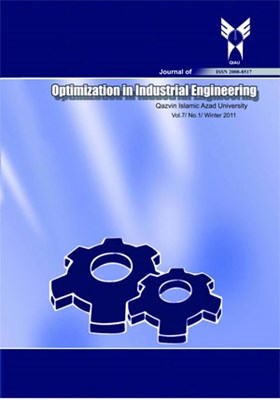A Novel Model for the Analysis of Interactions Between Governments and Agricultures in a Study of Social Beneficial Externalities Based on the Stackelberg Game: A Case Study on Cotton Production
Subject Areas : StrategyMohammad Ali Shafia 1 , Sayyede Ashraf Moousavi Loghman 2 , Aghdas Badiee 3 , Kamran Shahanaghi 4
1 - Associte Professor, Department of industrial engineering, Iran University of Science and Technology, Tehran, Iran
2 - Phd Student in Public Policy
3 - Phd Candidate
4 - Associte Professor, Department of industrial engineering, Iran University of Science and Technology, Tehran, Iran
Keywords:
Abstract :
Ai, X., & Shufeng, G. (2013). A Game Model Between Governments and Enterprises in the Green Supply Chain of the Home Appliance Industry. Journal on Innovation and Sustainability. RISUS ISSN 2179-3565, 4(1), 35-42.
Baldock, D., Hart, K., & Scheele, M. (2009). Public goods and public intervention in agriculture European network for rural development.
Bard, J. F. (1999). Practical Bilevel Optimization: Algorithms and Applications: Springer.
Bazaraa, M. S., Jarvis, J. J., & Sherali, H. D. (2011). Linear programming and network flows: John Wiley & Sons.
Brinkhuis, J., & Tikhomirov, V. (2011). Optimization: insights and applications: Princeton University Press.
Buckwell, A., Armstrong-Brown, S., Baldock, D., Bielenberg, N., Brouwer, F., & van Ittersum, M. (2009). Risk Task Force on Public goods from private land. Retrieved from
Chen, C.-H., Mai, C.-C., & Yu, H.-C. (2006). The effect of export tax rebates on export performance: Theory and evidence from China. China Economic Review, 17(2), 226-235.
Climate, E. a. T. D. (1999). Cultivating Our Futures - Taking Stock of the Multifunctional Character of Agriculture and Land. Retrieved from
Cui, L., Wu, K.-J., & Tseng, M.-L. (2016). Exploring a Novel Agricultural Subsidy Model with Sustainable Development: A Chinese Agribusiness in Liaoning Province. Sustainability, 9(1), 19.
Czyżewski, B., & Majchrzak, A. (2017). Market versus agriculture in Poland–macroeconomic relations of incomes, prices and productivity in terms of the sustainable development paradigm. Technological and Economic Development of Economy, 1-17.
Ding, B., & Huang, Y. (2012). Emergency Materials Supply Chain Coordination by the Joint Mechanism between Government and Enterprises. Asian Social Science, 8(8), 15.
Duan, T. (2010). An analysis on mining production and policy risk: Game between Chinese local government and mining investor. Paper presented at the 2010 IEEE International Conference on Advanced Management Science (ICAMS 2010).
Emam, O. (2006). A fuzzy approach for bi-level integer non-linear programming problem. Applied Mathematics and Computation, 172(1), 62-71.
Hemels, S., & Goto, K. (2017). Tax Incentives for the Creative Industries: Springer.
Hoekman, B., Olarreaga, M., & Ng, F. (2002). Reducing agricultural tariffs versus domestic support: what's more important for developing countries?
Huang, G. H. (1994). Grey mathematical programming and its application to municipal solid waste management planning.
Jeon, C., Lee, J., & Shin, J. (2015). Optimal subsidy estimation method using system dynamics and the real option model: Photovoltaic technology case. Applied Energy, 142, 33-43.
Kallhoff, A. (2014). Why societies need public goods. Critical Review of International Social and Political Philosophy, 17(6), 635-651.
Na, Z., & Fusheng, W. (2013). The game analysis of manufacturers’ political connections on product safety in supply Chain: evidence from China. Discrete dynamics in nature and society, 2013.
Rajan, R. G. (2012). Presidential address: The corporation in finance. The Journal of Finance, 67(4), 1173-1217.
Raymond, R. T. (2010). Determining approximate Stackelberg strategies in carbon constrained energy planning using a hybrid fuzzy optimisation and adaptive multi-particle simulated annealing technique.
Schaeffer, P. V., & Loveridge, S. (2002). Toward an understanding of types of public-private cooperation. Public Performance & Management Review, 26(2), 169-189.
Sheu, J.-B., & Chen, Y. J. (2012). Impact of government financial intervention on competition among green supply chains. International Journal of Production Economics, 138(1), 201-213.
Shih, H., Cheng, C., Wen, U., Huang, Y., & Peng, M. (2012). Determining a subsidy rate for Taiwan's recycling glass industry: an application of bi-level programming. Journal of the Operational Research Society, 63(1), 28-37.
Siggel, E., & Ssemogerere, C. G. (2000). Uganda’s Policy Reforms, Industry Competitiveness and Regional Integration: A comparison with Kenya.
Sinha, A., Malo, P., & Frantsev, A. (2013). Multi-objective Stackelberg Game Between a Regulating Authority and a Mining Company: A Case Study in Environmental Economics.
Spielman, D. J., & von Grebmer, K. (2006). Public–private partnerships in international agricultural research: an analysis of constraints. The Journal of Technology Transfer, 31(2), 291-300.
Stiglitz, J. E. (1987). Some theoretical aspects of agricultural policies. The World Bank Research Observer, 2(1), 43-60.
Tirole, J. (2010). The theory of corporate finance: Princeton University Press.
Van Long, N., & Stähler, F. (2009). Trade policy and mixed enterprises. Canadian Journal of Economics/Revue canadienne d'économique, 42(2), 590-614.
Vatn, A. (2001). Transaction costs and multifunctionality. Paper presented at the OECD Workshop on multifunctionality, Paris.
Wallace, A. (1994). Sense with sustainable agriculture. Communications in soil science and plant analysis, 25(1-2), 5-13.
Wu, T., Zhou, W., Yan, X., & Ou, X. (2016). Optimal policy design for photovoltaic power industry with positive externality in China. Resources, Conservation and Recycling, 115, 22-30.
Yang, Y., & John, R. (2003). Grey systems and interval valued fuzzy sets. Paper presented at the EUSFLAT Conf.
Yang, Z., Cai, J., Dunford, M., & Webster, D. (2014). Rethinking of the relationship between agriculture and the “urban” economy in Beijing: An input-output approach. Technological and Economic Development of Economy, 20(4), 624-647.
Zhao, R., Neighbour, G., McGuire, M., & Deutz, P. (2013). A software based simulation for cleaner production: a game between manufacturers and government. Journal of Loss Prevention in the Process Industries, 26(1), 59-67.


